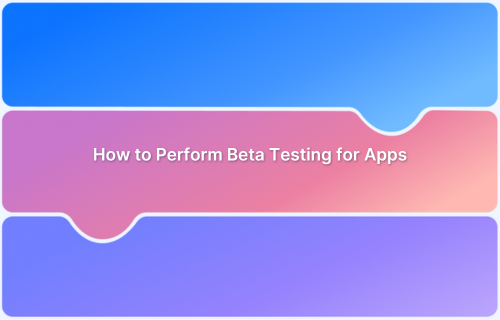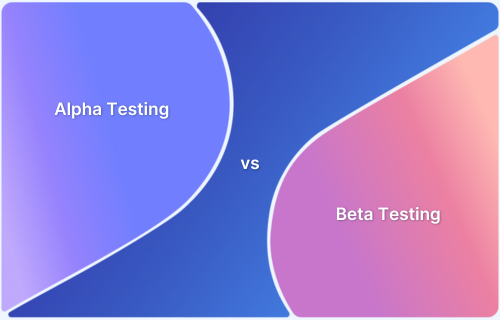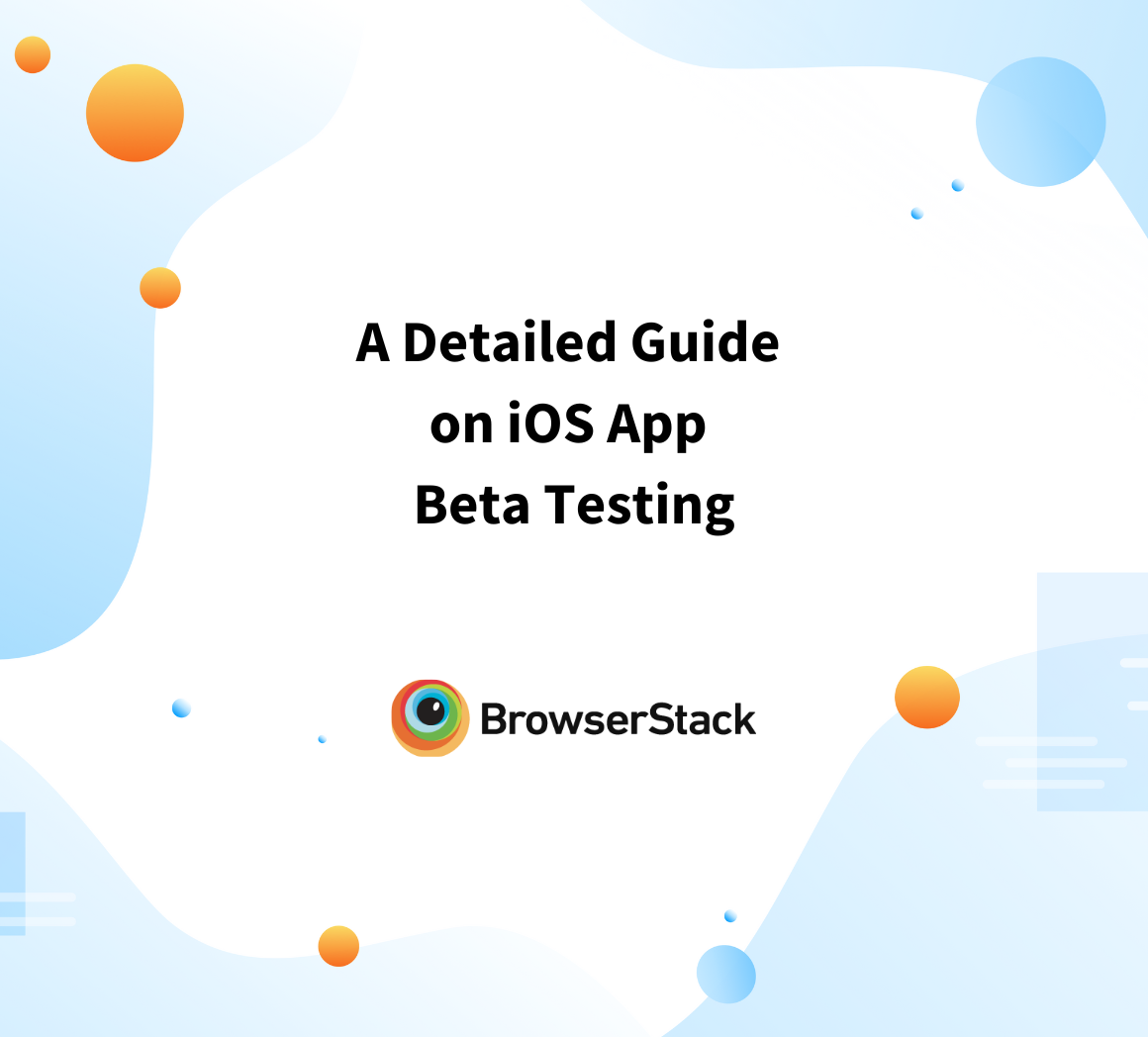Top 15 Beta Test Tools
By Sandra Felice, Community Contributor - January 3, 2025
Beta testing is crucial in software development to deliver high-quality applications. The developers using this phase can get real user feedback before releasing the final product. Using beta testing tools makes this process more efficient, allowing teams to identify problems and improve user experiences.
This article will explore the top 15 beta testing tools that can improve your beta testing process.
- What is Beta Testing?
- What are Beta Testing Tools?
- Importance of Beta Testing Tools
- Top 15 Beta Testing Tools
- 1. TryMyUI
- 2. Marker.io
- 3. UserTesting
- 4. Instabug
- 5. UXCam
- 6. Rainforest QA
- 7. Centercode
- 8. Test IO
- 9. Userbrain
- 10. Jira
- 11. Applause
- 12. Adobe XD
- 13. TestFlight
- 14. Usersnap
- 15. Bugsee
What is Beta Testing?
Beta testing is the stage in the software development lifecycle where a version of the software is released to a select group of users outside the development team. This phase identifies bugs, gathers user feedback, and evaluates overall usability. So, by beta testing, the Real users interact with the application in real user conditions, and can provide invaluable suggestions for improvements to the application before the final release.
What are Beta Testing Tools?
Beta testing tools are software applications that help developers perform the beta testing process. These tools make it much easier for developers to find and fix issues, improving the process of user feedback collection, issue tracking, and performance evaluation. Using these tools allows teams to work better together and move more seamlessly from beta to final release.
Also Read: What is Alpha Testing?
Importance of Beta Testing Tools
Beta testing tools are crucial because they provide structured ways to efficiently gather user feedback and track defects. They allow teams to understand how real users interact with their product, identify critical issues, and ensure the application is ready for public release. Utilizing these tools can significantly reduce post-launch problems and improve user experience.
Also Read: What is UX testing with example
Top 15 Beta Testing Tools
Here is a list of top 15 Beta testing tools:
1. TryMyUI
TryMyUI is a user testing platform that offers video feedback from real users as they interact with your website or app. It provides a user-friendly interface for setting up tests and selecting demographics. Testers complete specific tasks and record their thoughts so usability issues become easily seen.This platform is valuable for teams looking to enhance user experience by understanding real user interactions.
Pros:
- Provides video recordings for a better understanding of user behavior.
- Offers qualitative feedback along with usability metrics.
Cons:
- Limited to English-speaking testers, which may not represent all user demographics.
- The analysis can be subjective, relying on user interpretation.
TryMyUI is good for gaining visual insights into user experiences but cannot provide feedback in multiple languages.
2. Marker.io
Teams can instantly capture the visual aspect of the application directly via Marker.io and then easily report bugs and collaborate on fixes. Screenshot annotation allows users to clearly point out errors where the line of communication between a tester and a developer is better.Integration with popular project management tools improves its functionality and workflow. This tool is ideal for teams that prioritize visual documentation in their feedback process.
Pros:
- Integrates seamlessly with popular project management tools like Jira and Trello.
- Enables users to annotate screenshots for clear communication.
Cons:
- Requires internet access, which can be limiting in certain environments.
- The free version has limitations on the number of feedback items.
Marker.io is good for visually documenting bugs in real time, but it cannot function without an internet connection.
3. UserTesting
UserTesting provides a platform for getting real time feedback from users as they interact with your product, using video, audio, and written insights. With a diverse pool of testers, teams can gather feedback from various demographics. The platform’s ease of use allows for rapid setup and execution of tests, leading to quick insights. This tool is perfect for companies looking to gain a deeper understanding of user needs & preferences.
Pros:
- Offers a diverse pool of testers, enabling testing across various demographics.
- Provides comprehensive insights into user behavior and preferences.
Cons:
- Pricing can be on the higher side for small teams.
- The setup process can be time-consuming.
UserTesting is good for gathering diverse user insights quickly, but it cannot be cost-effective for small businesses.
Also Read: Top 20 Performance Testing Tools in 2024
4. Instabug
Instabug is a bug reporting and in-app feedback tool that allows users to report issues & provide feedback directly from the app. Users can attach screenshots of their issues and provide a quick description in order to help developers understand what’s wrong faster. This tool also provides integrations to already existing workflows that improve efficiency. Instabug is a perfect option for teams wanting to simplify feedback collection.
Pros:
- Users can send detailed bug reports, including device information and screenshots.
- Integrates easily with existing workflows like issue trackers.
Cons:
- It can overwhelm users with too many prompts for feedback.
- Limited customization options for feedback forms.
Instabug is good for efficiently capturing in-app feedback but cannot effectively limit user prompts.
5. UXCam
UXCam is a mobile analytics tool that helps teams understand user behavior by recording sessions and generating heatmaps. The session replay feature allows developers to see exactly how users navigate the app, highlighting potential pain points. Heatmaps provide a visual representation of user interactions, making it easier to analyze engagement. This tool is valuable for mobile development teams aiming to improve user experience based on real data.
Pros:
- Provides detailed session replays for better analysis of user interactions.
- Heatmaps help visualize user engagement with different app areas.
Cons:
- It only focuses on mobile applications, which may not suit all projects.
- Requires time to set up and analyze data effectively.
UXCam is good for visualizing user behavior in mobile apps but cannot be used for web applications.
6. Rainforest QA
Rainforest QA offers a unique crowd testing platform that combines automated testing with real user feedback, making it a versatile option for teams. The platform allows teams to leverage a large pool of testers for fast and efficient testing. It provides both automated and manual testing giving it complete coverage and faster release cycles. This is especially considered a useful tool for teams that need iteration quickly without sacrificing quality.
Pros:
- Allows for rapid testing by a large pool of real users.
- Combines both manual and automated testing processes for efficiency.
Cons:
- Pricing can be complex, depending on usage.
- Limited control over individual tester selection can lead to variability in feedback quality.
Rainforest QA is efficient at combining manual and automated testing, but it cannot provide consistent tester quality without careful selection.
7. Centercode
Centercode is a comprehensive beta testing platform to manage user feedback throughout the software development lifecycle. It enables teams to organize beta tests, recruit participants and gather valuable insights directly from users. The tool provides robust reporting features that help visualize data, making it easier to analyze feedback & identify trends. Centercode’s collaboration tools facilitate communication between testers and developers, enhancing the testing process.
Pros:
- Offers a centralized platform for managing beta tests and feedback collection.
- Robust reporting and analytics features help teams identify trends and insights.
Cons:
- Learning curve for new users for navigating extensive features.
- Pricing can be on the higher side for small teams or startups.
Centercode is excellent for managing comprehensive beta testing programs but may be complex for smaller teams looking for simplicity.
Also Read: 10 Best Alpha Testing Tools
8. Test IO
Test IO is a crowd testing platform that connects businesses with a global community of testers for on-demand beta testing. It allows companies to gather real-world feedback from diverse user perspectives, ensuring that applications meet customer expectations. Test IO supports many devices and platforms and will enable easy testing of applications in realistic conditions. It works well for agile development environments because of its quick turnaround times for getting feedback.
Pros:
- Quick access to a diverse pool of testers across multiple devices & platforms.
- Provides detailed bug reports with multimedia attachments to help developers.
Cons:
- May result in variable quality of feedback depending on the tester’s expertise.
- Limited control over testers’ assignment to a specific project.
Test IO is ideal for companies that seek rapid feedback from real users but may have variability in tester quality.
9. Userbrain
Userbrain is a user testing platform that allows teams to gather insights from real users as they interact with their applications. The tool records user sessions, providing valuable video feedback highlighting pain points and improvement areas. According to Userbrain, it is all about simplicity: the ability to set up tests quickly and with no preparation and receive actionable insights. If your team seeks to improve user experience through direct feedback, it is a great option.
Pros:
- A simple setup and quick feedback loop help teams gather insights efficiently.
- Provides video recordings of user sessions for clear visibility into user behavior.
Cons:
- Limited customization options for creating tailored testing scenarios.
- Reports can be basic and lack in-depth analysis compared to more advanced tools.
Userbrain is perfect for teams seeking straightforward user insights but lacks advanced reporting features for deeper analysis.
Also Read: What is User Acceptance Testing?
10. Jira
Jira is a widely-used project management tool that includes features for managing beta testing processes. While primarily focused on issue tracking and project management, Jira’s integration capabilities allow teams to incorporate user feedback from beta testing into their workflows seamlessly.With customizable workflows and robust reporting tools, Jira helps teams track beta testing progress and manage user feedback effectively. The best part about this is that those teams already using Jira for project management will find it particularly useful.
Pros:
- Integrates well with other tools and allows for customizable workflows.
- Robust issue tracking and reporting capabilities help manage user feedback efficiently.
Cons:
- May be overwhelming for new users due to its extensive features and options.
- Primarily focuses on project management, which may not be tailored specifically for beta testing.
Jira is excellent for teams looking to integrate beta testing feedback into project management but may be complex for users focused solely on testing.
11. Applause
Applause offers a comprehensive platform for beta testing that combines real users, professional testers, and automation to deliver high-quality feedback. It enables companies to run beta tests across various devices and operating systems, providing valuable insights into user experience and functionality. Applause’s platform is designed for scalability, making it suitable for both small startups and large enterprises. The tool’s flexibility allows teams to customize their testing processes according to specific project needs.
Pros:
- Provides access to a large community of testers for diverse feedback.
- Scalable platform suitable for companies of all sizes and testing needs.
Cons:
- Can be expensive for smaller teams or projects with limited budgets.
- The platform’s complexity may require learning and fully utilizing its features.
Applause is an excellent choice for businesses seeking diverse feedback from real users but may be cost-prohibitive for smaller teams.
12. Adobe XD
Adobe XD is a powerful design and prototyping tool that allows teams to create interactive user experiences for testing. While primarily focused on design, it also offers features for gathering feedback during the beta testing phase. Users can share prototypes with stakeholders and testers, enabling them to comment directly on the designs. This collaborative approach allows teams to refine their applications on real input of the users before going for the final launch.
Pros:
- Seamless integration with other Adobe Creative Cloud tools enhances workflow efficiency.
- Interactive prototyping features allow for realistic user experience testing.
Cons:
- Lacks dedicated beta testing management features, which may limit its usability for some teams.
- Requires familiarity with design concepts that may not be suitable for all testers.
Adobe XD is great for teams focusing on design and prototyping but may not provide robust testing management features.
13. TestFlight
TestFlight is Apple’s official beta testing platform for iOS applications, allowing developers to distribute their apps to testers seamlessly. Teams can use it to invite users to test pre-release versions of their apps over the platform and get real time feedback. TestFlight offers tools to manage builds & view crash reports, making it easier to identify and resolve issues. This is an integration with the Apple ecosystem for iOS developers which makes it much easier.
Pros:
- Direct integration with the App Store simplifies the testing and distribution process for iOS apps.
- Provides comprehensive crash reports and feedback from testers.
Cons:
- Limited to iOS applications which restricts its usability for cross-platform projects.
- Requires Apple Developer Program membership, which can be a barrier for some developers.
TestFlight is ideal for iOS developers looking for an integrated testing platform but is limited to the Apple ecosystem.
Also Read: A Detailed Guide on iOS App Beta Testing
14. Usersnap
Usersnap is a feedback & bug tracker tool that makes user testing easy with user reporting right from the app. It captures screenshots and records user interactions, enabling teams to understand exactly what users experienced. This visual feedback helps streamline communication between testers and developers, ensuring issues are addressed quickly.
Pros:
- Offers visual feedback with screenshots and annotations, making issue reporting clear and concise.
- Integrates with popular project management tools to streamline the workflow.
Cons:
- It may require additional setup to utilize all features, especially for larger teams fully.
- Limited analytics capabilities compared to more comprehensive testing platforms.
Usersnap is effective for teams needing clear visual feedback but may require more setup to maximize its capabilities.
15. Bugsee
Bugsee is a mobile debugging tool that captures both user sessions and application logs to provide insights into bugs and issues during beta testing. It records videos of user sessions alongside error reports, helping teams identify and resolve problems more effectively. Bugsee’s focus on mobile applications makes it an excellent choice for developers looking to enhance the quality of their mobile products. Its user-friendly interface allows teams to review issues quickly and collaboratively.
Pros:
- Combines session replay with error logging for a comprehensive view of issues.
- User-friendly interface makes it easy to navigate and review feedback.
Cons:
- Primarily focused on mobile applications, limiting its usability for web projects.
- Advanced features may require a learning curve for new users.
Bugsee is perfect for mobile developers seeking detailed debugging insights but may not be suitable for web application testing.
Key Features of Beta Testing Tools
Some of the key features of beta testing include:
- User Feedback Collection: Surveys, forms, and direct comments make gathering feedback from beta testers with tools easy.
- Bug Reporting and Tracking: With integrated systems, testers can sometimes report bugs directly by adding session recordings or screenshots.
- Version Management: Support for managing multiple app versions during the beta testing phase to track changes and tester feedback effectively.
- User Analytics: Analytics features are often tools that allow you to monitor the user behavior, engagement and, therefore, the overall application performance.
- Collaboration Features: Many platforms offer collaboration tools for teams to communicate, share feedback, and make decisions based on tester input.
- Integration Capabilities: Integrating with other development and project management tools for a streamlined workflow.
- Customizable Testing Criteria: Options to set specific testing parameters and criteria tailored to the project’s goals.
- Real-time Updates: Features allowing immediate feedback collection and issue tracking, helping teams respond quickly to user needs.
- Security and Privacy Controls: These help protect user data during beta testing, especially for sensitive apps.
- Reporting and Analytics Dashboards: This company offers complete dashboards that cover feedback, bug reports, and testing metrics so you can analyse them easily.
Types of Beta Testing
Below are the different types of beta testing:
- Open Beta Testing: Open beta testing allows users to participate, providing broad feedback and insights. This type often targets a large audience to uncover various issues and gather diverse user experiences.
- Closed Beta Testing: In closed beta testing, a select group of users is invited to test the application. This approach offers more controlled feedback and allows developers to focus on specific user demographics or use cases.
- Focus Group Testing: Focus group testing involves gathering a small group of users to provide detailed feedback on specific application features or aspects. This method is ideal for obtaining in-depth insights and understanding user motivations.
- Post-Release Beta Testing: Conducted after an application’s official release, this type of beta testing focuses on gathering feedback from real-world users to identify any remaining issues or areas for improvement.
How to Perform Beta Testing
The approach to performing beta testing can vary significantly based on the type being utilized:
Step 1: Set up an accessible platform for users to sign up, provide feedback and use feedback tools to gather insights from a large user base.
Step 2: Invite specific users to participate, provide a controlled environment to test the application, and encourage targeted feedback based on predetermined criteria.
Step 3: Organize sessions with a small group of selected users, guiding discussions and collecting qualitative feedback on particular features or user experiences.
Step 4: Use analytics and feedback tools to monitor user interactions with the released product and encourage users to report any issues they encounter during regular usage.
Using BrowserStack to Perform Developer Beta Testing
BrowserStack is a powerful tool for performing developer beta testing, allowing teams to test their applications across a multitude of real devices and browsers.
Following are some of how you can leverage BrowserStack effectively in a developer beta testing environment:
- Cross Browser Testing: BrowserStack enables developers to test their applications on over 3500 real browsers and devices, ensuring compatibility across various platforms. This feature is essential during beta testing to catch any discrepancies arising from different environments.
- Live Interactive Testing: Developers can interact with their applications in real-time, quickly identifying and resolving issues. This immediate feedback loop is crucial for making adjustments before the official release.
- Automated Testing: BrowserStack’s automated testing capabilities allow developers to run a suite of tests against their beta applications, ensuring that core functionalities work as expected. Automated tests can save time and help identify bugs that may be missed during manual testing.
- Debugging Tools: Built-in tools allow developers to inspect elements and debug issues and make necessary changes directly within the testing environment. This capability enhances the efficiency of the testing process.
- Geolocation Testing: Developers can simulate user experiences from different geographic locations, helping to uncover location-specific issues that could affect user experience in various markets.
Conclusion
Beta testing is a critical phase in the software development lifecycle. It provides valuable insights from real users and identifies issues that need resolution before the final release. Utilising beta testing tools enhances this process by offering features that streamline feedback collection, issue tracking, and user interaction analysis.
From open to closed beta testing, different strategies cater to varying user engagement levels and feedback needs. By leveraging robust tools like BrowserStack and the other beta testing tools mentioned, teams can optimize their applications and ensure a successful launch.












